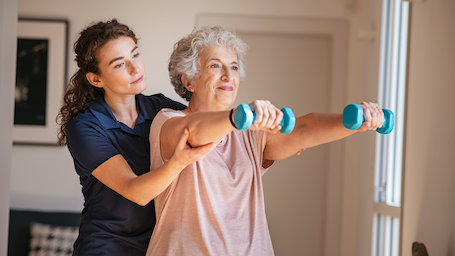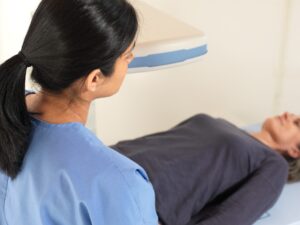
Breast cancer puts you at risk for osteoporosis—that’s a fact.1 But knowledge is your very breast friend, and it’s important to know about the link between these diseases. For National Osteoporosis Month, we’re giving you the knowledge to protect your breasts and your bones.
What’s Osteoporosis?
Osteoporosis is a disease that impacts your bone health, progressively weakening bone strength and thickness—putting you at high risk for breaks and fractures.2 Early warning signs are not very common, and diagnosis often comes after you break a bone.3
The gist: Osteoporosis thins the outside and inside of your bones, breaking their structure down. Fractures can happen easily, and it doesn’t take all that much force.2 We know this might sound a little scary, but it’s a disease that affects a lot of us women. Especially if you have, or have had, breast cancer.1
Because breast cancer diagnoses are increasing, as well as survival rates, more women are facing higher chances of suffering from both breast cancer and osteoporosis.4

What Women Need to Know
So, what exactly does breast cancer have to do with osteoporosis? Good question. The most common type of breast cancer is estrogen-based, and cancer treatments work by starving the cancer of estrogen.4 This is great when it comes to effective treatment, BUT lack of estrogen is not so hot for your bone health.
Osteoporosis is also often tied to menopause. When women go through this phase of life, less estrogen is produced which reduces bone density and can weaken your bone strength.5 If you have breast cancer, chemotherapy can affect your ovaries, potentially causing early menopause.2 An early menopause could mean developing osteoporosis.

Hologic, Inc.
Learn whether you are at risk for osteoporosis with a Horizon® DXA System by Hologic® exam. Find an exam near you!
How Can I Keep ‘Em Healthy?
When you have breast cancer, the last thing you want to worry about is another disease. We understand. It’s definitely concerning! The good news is that there are things you can do to protect your bone health. But before starting any diet or exercise, please consult your physician first.
Your bones love good old calcium and vitamin D. The National Institutes of Health recommends that eating a diet rich in these nutrients could go a long way in terms of limiting your risk of developing osteoporosis. Foods like low-fat dairy products and dark green, leafy vegetables are all excellent sources of calcium.1 Vitamin D is super important for bone health because it helps with calcium absorption. Liver is high in this vitamin, but if eating animal organs isn’t your thing (we don’t blame you), you can up your vitamin D intake by incorporating egg yolks and saltwater fish into your diet.1 For more info on how much calcium and vitamin D you need, check out this reference.
When you want to strengthen your muscles, you hit the gym. Your bones also respond to resistance exercises—like lifting weights—to make them stronger!1 And then there are low-impact weight-bearing exercises that force you to work against gravity.1 You could do things like taking a walk around the neighborhood, opting for the stairs over an elevator, and going out dancing.1 Here’s a great reference for more tips to keep your bones safe. As always, though, make sure to check with your doc before starting any new exercise plan.
Protect Your Breasts & Bones with Preventive Care
Another step you can take is asking your doctor whether you might be a candidate for a bone density test.1 This screening can determine if your bones are potentially at risk of osteoporosis. Horizon® DXA System by Hologic® uses densitometry technology, and the dual-energy X-ray does more than just measure bone density. Horizon DXA System has features for a complete fracture risk assessment and more.6 A woman’s risk of breaking a hip due to osteoporosis is equal to her risk of breast, ovarian, and uterine cancer combined.7 Early detection is key to keeping patients like us safe.8
One in two women in the U.S. age 50+ will sustain an osteoporosis fracture.7 Early osteoporosis detection is key to keeping you safe. Early detection of breast cancer is ALSO a key to your safety. Only the Genius® 3D™ exam finds 20%-65% more invasive breast cancers compared to 2D alone. It can mean an earlier diagnosis and a greater variety of treatment options available to you.9 Plus, earlier detection gives you the heads-up to pay particular attention to bone health, so you can limit your risk of osteoporosis.
If screenings have fallen off your radar due to COVID, now’s the time to get your health back on track. Why not schedule both procedures at the same time? Find a Genius® exam near you here. Learn whether you are at risk for osteoporosis and find a DXA exam near you at findmydxa.com.
References
- What Breast Cancer Survivors Need To Know About Osteoporosis. National Institutes of Health. https://www.bones.nih.gov/health-info/bone/osteoporosis/conditions-behaviors/osteoporosis-breast-cancer#b. Accessed January 10, 2022.
- Breast Cancer and Osteoporosis. Breast Cancer Now. https://breastcancernow.org/information-support/facing-breast-cancer/going-through-treatment-breast-cancer/side-effects/bone-health-osteoporosis. Accessed January 10, 2022.
- Osteoporosis Overview. National Institutes of Health. https://www.bones.nih.gov/health-info/bone/osteoporosis/overview. Accessed January 17, 2022.
- Cancer and Osteoporosis. Bone Health and Osteoporosis Foundation. https://www.bonehealthandosteoporosis.org/2018/05/24/cancer-and-osteoporosis/. Accessed January 10, 2022.
- Bone Strength After Menopause. Breastcancer.org. https://www.breastcancer.org/treatment-side-effects/menopause/long-term-health/bone-strength. Accessed April 28, 2022.
- Horizon® DXA System. Hologic. https://www.hologic.com/hologic-products/skeletal-solutions/horizon-dxa-system. Accessed February 14, 2022.
- What Women Need to Know. Bone Health and Osteoporosis Foundation. https://www.bonehealthandosteoporosis.org/preventing-fractures/general-facts/what-women-need-to-know/#:~:text=Here%20are%20some%20facts%3A,breast%2C%20uterine%20and%20ovarian%20cancer. Accessed April 28, 2022.
- Are You At Risk?. Bone Health and Osteoporosis Foundation. https://www.bonehealthandosteoporosis.org/preventing-fractures/general-facts/bone-basics/are-you-at-risk/. Accessed April 6, 2022.
- Results from Friedewald, SM, et al. “Breast cancer screening using tomosynthesis in combination with digital mammography.” JAMA 311.24 (2014): 2499-2507; a multi-site (13), non-randomized, historical control study of 454,000 screening mammograms investigating the initial impact the introduction of the Hologic Selenia Dimensions on screening outcomes. Individual results may vary. The study found an average 41% (95% CI: 20-65%) increase and that 1.2 (95% CI: 0.8-1.6) additional invasive breast cancers per 1000 screening exams were found in women receiving combined 2D FFDM and 3D™ mammograms acquired with the Hologic 3D Mammography™ System versus women receiving 2D FFDM mammograms only.
SOM-01217
Disclaimer: The content in this piece is for information purposes only and is not intended to be medical advice. Please contact your medical professional for specific advice regarding your health and treatment. This information may be relevant in the U.S. and other markets and is not intended as a product solicitation or promotion where such activities are prohibited. Because Hologic materials are distributed through websites, eBroadcasts and tradeshows, it is not always possible to control where such materials appear. For specific information on what products may be available in a particular country, please write to womenshealth@hologic.com.